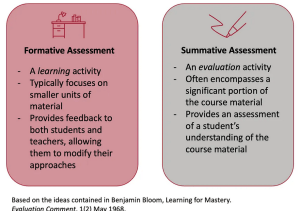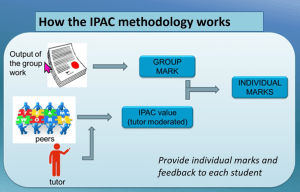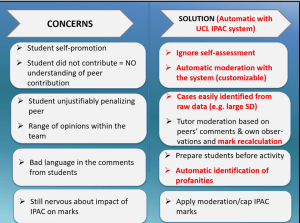What is Peer Assessment?
Peer assessment is the process whereby students evaluate and provide constructive feedback to their peers, this can be on an actual piece of work or on the level of contribution, professional behavior and skills demonstrated during a group project. Many academics across different institutions in the UK have built peer assessment and feedback activities into their teaching to facilitate student engagement.
Types of Peer Assessment
- Peer grading is achieved online using digital education tools whereby students assess and give feedback to their peers on a piece of work, this could be a report, a presentation, etc. Students grade their peers using an online rubric for a particular assignment and record their final scores.
- Individual Peer assessment of contribution to group work (IPAC) is when members of the group evaluate the level of contribution and skills, aptitudes and performance of their peers demonstrated during a group project. For e.g. ability to work in a team, communication, leadership, and planning skills, etc.
- Self-assessment is when a student critically reflects on their own learning and records their progress when completing an assignment. Self-assessment can also be carried out using IPAC.
Formative and Summative Peer Assessment
Peer assessment can either be formative or summative depending on the academic and how they would like to assess their students. Formative peer assessment involves feedback on drafts of work to enable students to modify their work before submitting their final copy. This could be through feedback, mid-point in a group project on how the group is working together, so behaviours and approaches can be adjusted to make the team more successful. In contrast, summative involves evaluating the final result of someone’s work, or the overall behaviors and skills demonstrated during a group activity, which is assessed at the end of the project. As highlighted by Bloom (1968) see Figure 1, both formative and summative assessments entail different activities.

Figure 1: Formative vs. Summative Assessment based on the ideas contained in Benjamin Bloom, Learning for Mastery. Evaluation Comment, 1(2) May 1968.
Why use Peer Assessment?
Peer assessment can:
- Help students to develop lifelong and transferable skills, that they can utilise after graduating
- Allow students to understand the scope of the assignment, the level of performance/quality of work expected which leads to self-assessment and improvement of their own work.
- Allow students to receive timely feedback – particularly useful to give feedback on drafts
- Encourage students to engage more profoundly with the course material and move up on the Bloom’s pyramid of learning
- Improve student team cohesion and performance
- Enable peers to identify mistakes and provide suggestions for improvement when rubrics are used.
IPAC
The Individual Peer Assessment of Contribution to group work (IPAC) assessment methodology has been around for quite some time and it is successfully used in many HE institutions. The implementation of this practice was very time consuming due to the lack of a suitable digital tool, but that has now been solved. UCL has developed the IPAC system, led by Dr Pilar Garcia Souto from the Engineering Faculty. The IPAC tool runs via Moodle, and it makes the implementation of this assessment very easy and time efficient, addressing students’ feedback and concerns on group work assessment as well as improving feedback. The IPAC system is currently used by many UCL departments and faculties both with formative and summative purposes. Other HE institutions have also shown interest in the IPAC system and adopted it recently.
How the IPAC methodology works
A group of students work together and submit a group deliverable, this can be anything that the staff chose, e.g. a report, a poster, a physical prototype or a piece of art. This gets assessed by the staff and generates a “group mark”. Additionally, at some key points in the project (typically at least at the end) the staff asks students to assess each other in terms of contribution, behavior within the group etc using the IPAC system. This gets reviewed by the staff and leads to an “individual IPAC mark”. These two scores then get combined (the “group mark” and the “individual IPAC mark”) to generate an “final individual mark” that reflects how well a student’s team did but also how well the student did within the team.
IPAC works well at the end of a group project, as it allows tutors to give individual marks to each student. However, IPAC can also be used for formative purposes:
- At the initial stage of the project, so tutors can see if there are any students that are not engaged or teams with poor group dynamic. This allows the tutor to identify and address any issues before they become more problematic, e.g. talk to certain students, or modify certain groups.
- After submission of interim assignments related to the project, particularly in long projects, such that we keep monitoring student engagement and allow students to address any criticisms and improve the way they work within the team.

Benefits of IPAC methodology
- Fairer marks
- Encourages students’ engagement and professional behaviour
- Welcome by students
- Can be used for formative or summative purposes, and at various stages in a project
- Insightful for staff, e.g. identify potential issues at early stages
- Constructive feedback
- More insightful to students, e.g. they see how their contribution is perceived and how they can improve
- Opportunities for student development writing and receiving feedback
- The tool saves a huge amount of time
How the IPAC system works
- Add IPAC to your Moodle course as any other activity.
- Staff create a questionnaire (built-in template available).
- Students complete the questionnaire.
- Staff analyse the data.
- Staff reviews/moderates/finalise marks.
- Staff release personalised marks and feedback to students (summative and formative).
- Students view marks and feedback on the IPAC system or/and gradebook.
Issues addressed so far

One of the common questions that have been asked, is whether peer review is time consuming, and the answer is ‘NO’ if you use the UCL IPAC system. The reasons as to why peer assessment is not time consuming is because the IPAC system:
- Minimises staff time in setting up and running peer feedback.
- Significantly reduces time spent due to student complaints.
- Allows you to focus on critical cases.
Dr Pilar will be running 2 types of training sessions on IPAC:
1. IPAC introductory seminar: Introduction to the Individual Peer Assessment of Contribution to group work methodology. This course covers the basis of how it works and how it can be implemented in your group work activity. It also looks at typical questions/worries of academic staff and is perfect for those of you who are new to the IPAC assessment methodology. The introductory seminar will run on the following dates/times:
4th June 2024, 10-11am
9th July 2024, 10-11am
16th September 2024, 10-11am
2. New IPAC workshop: A new version of the IPAC system is being released and will fully sit within Moodle with no separate apps making it easier to use. It also has added features that provide more information/facilities for the tutors. In this workshop we demonstrate the new version of the IPAC system and use a hands-on approach on how to use it.
4th June 2024, 11.15am-12.15pm (optional further consultation until 12.45pm)
9th July 2024, 11.15am-12.15pm (optional further consultation until 12.45pm)
16th September 2024, 11.15am-12.15pm (optional further consultation until 12.45pm)
To book any of these sessions then refer to this link: MS Forms
If you wish like to learn more about IPAC then contact Dr Pilar Garcia Souto: p.garciasouto@ucl.ac.uk
Full information about the IPAC system, with videos on how to implement it in UCL Moodle and also relevant resources can be found in the link: https://www.ucl.ac.uk/engineering/ipac/help/index.html
References:
Bloom, B. S. (1968). Learning for mastery. Evaluation Comment, 1(2), 1-12.
This blog has been written by both Nadia Hussain and Dr Pilar.
